Resuenen: Interpretive Views of the Border
BY MICAELA GARDNER
Note: This essay was first published in Stance on Dance’s spring/summer 2023 print issue. To learn more, visit stanceondance.com/print-publication.
In July 2020, while living on the Sea of Cortez, I developed the idea for making Resuenen. Having recently left the United States, crossing the border near Yuma, Arizona, the taste and experience of the borderlands was fresh in my mind. Media noise regarding the upcoming presidential election and the traumatic disarray of border policy and practice stimulated my thought of making a collaborative video piece reflecting on the ongoing border crisis. I chose the title Resuenen, as it refers to a group echoing or resonating and my wish that many perspectives be woven into the project.
My background is modern dance with site work and dance on film being of particular focus. My intention with Resuenen was to both direct the project and contribute original dance video work. I imagined the resultant video work would be screened in conjunction with similarly themed performative and visual work; in the midst of poets, dancers, sculptors, and social justice advocates and specialists, all giving weight to an atmosphere of inquiry and ideas for humane solutions at the border.
I set about building a small core team made up of former colleagues and collaborators from my years in the Bay Area. I was delighted to be joined by video artist and editor Darren Hawk, and musicians/composers Thomas Carnacki and Damon Smith.
Seeking varied voices and a collective quality for the building of Resuenen, I next cast about for submissions of relevant material to meet my own. A significant part of my approach was creating a project website with Google: free and perfectly serviceable! After a few months of correspondence, the project had 14 collaborators. Over the following year, in came short videos, longer videos, poems, songs, and photographs. In many cases, work was created specifically for Resuenen. In a few instances, artists had work on hand that applied beautifully.
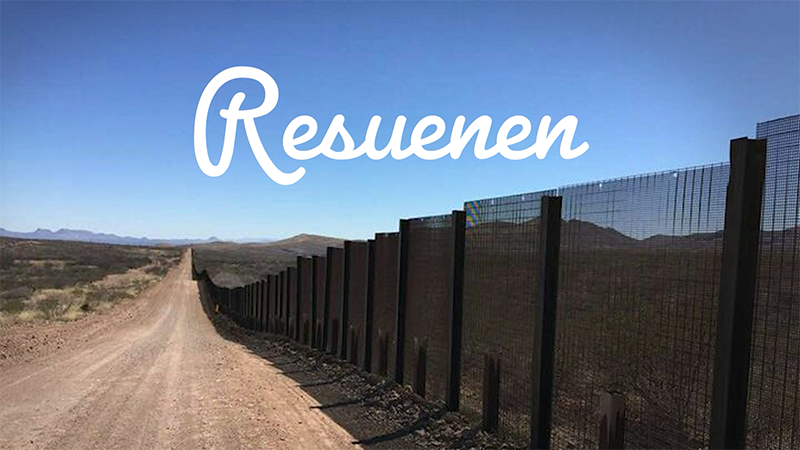
Resuenen still
By August 2020, I was developing the work I would personally bring to the project. I devised three dance characters inhabiting roles within what I construed to be a colonial economy or culture. I wanted to show socio-economic division but also a deeper, ethereal sense of connection. I also wanted to refer to the religious conversion tactics of the original conquests in Mexico and the Southwest; to draw connections to the frontier’s present from its colonial past.
The first character I refer to as the prisoner. She moves neurotically in a spare room with a single chair. She is hooded and faceless, trapped and absurd, making her way in fits to the door she exits through. Cut into this interior action comes the latter two characters, the prophet and the acolyte. They feature in something of a televangelist broadcast – the prophet delivering a scornful mass and the acolyte flexing, hooded like the prisoner, in the background as choir.
This broadcast reaches into the mind (room) inhabited by the prisoner, asserting religious control.
After several minutes of what could be described as torture, the prisoner exits the room into a tidal beachscape, walking for a time and then entering the sea. From her green submersion emerges both still images and another sequence of action. The prophet, in his second appearance, is lost and disoriented in a desert landscape. He bumbles, panicked and abandoned, in the vastness. Spasms of self-mockery alternating with lordly gloating give way to machine-like action conveying heartless surveillance.
Following the prophet’s antics in the desert, the prisoner appears in the same landscape. Her movement language has transformed to evoke the actions of borderlands animals: coyote, hawk, and rattlesnake. The prisoner’s efforts to pierce into animal essence ultimately release her to a plain of ecstatic levitation. Her connection to the physical environment liberates her from her chamber or colonized mind.
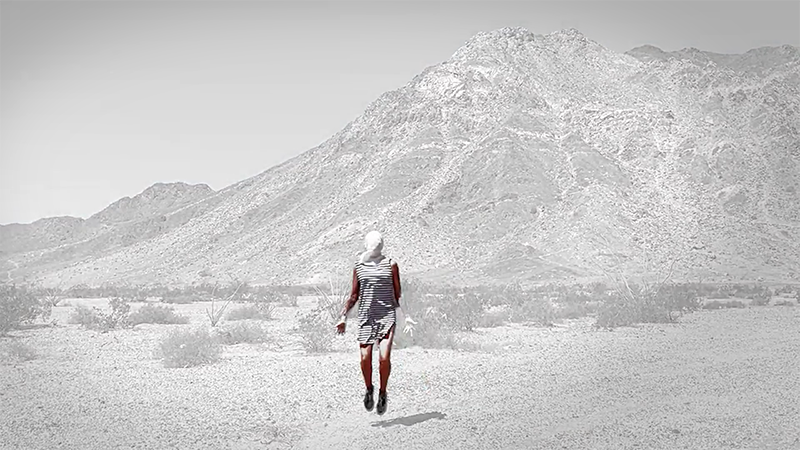
Resuenen still
Leaving the water, the prisoner continues her walk until reaching once more the interior we saw her in first. Removing her hood, she gazes into the room to see the acolyte, face obscured, dancing inside. She enters, sitting opposite the acolyte, who then removes their hood also, revealing that the two are the same person.
The acolyte represents the part of the prisoner enthralled by or working for the prophet. The revelation of these two characters being one and then exiting the room together expresses a divestment of their oppositional paradigm. The characters’ movement through border landscapes evokes the travel and hardship experienced by migrants on the frontier. The resolve of unification between the characters is a prayer for human understanding and compassion that could influence border politics.
After completing the lengthy process of editing my work, Darren Hawk continued to the overall edit of all contributed works. With my direction, the varied parts were blended, creating a colorful and somewhat psychedelic whole. Darren’s graceful patience throughout Resuenen‘s process has been incredible! He is the most important working part of this project.
While I could write at length about all the work collected to make Resuenen, I will limit myself to the mention and interpretation of three pieces.
Arturo Ramon’s “Frontera” opens Resuenen. It is a kaleidoscopic color study set to a shimmering, ringing sound score. From an ever-changing, circular center, it shifts and merges upon itself like the activation of a mandala. It reaches me as an incantation that somehow softly destroys the border’s coarse line, leaving a resonating freedom to savor there.
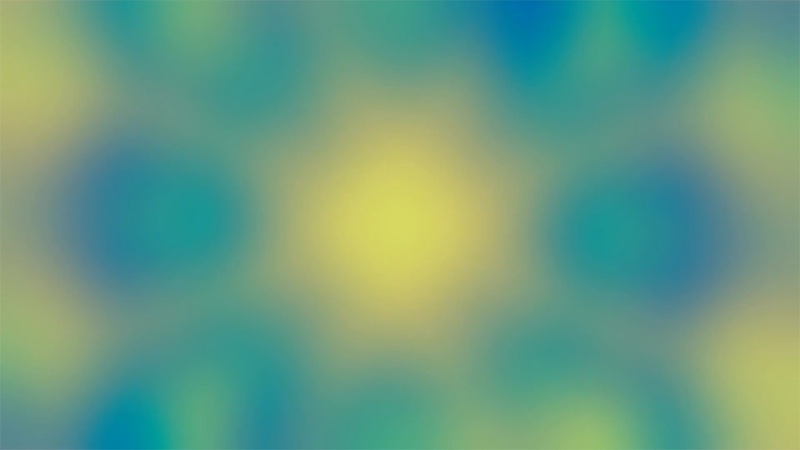
A still from Arturo Ramon’s “Frontera”
Taking up much of Resuenen‘s first half is “Latente,” created by Sandra Paola López Ramírez and colleagues. We hear minimal jazz and female vocal utterances, while an apparently pregnant dancer swirls and pounces in a shadowy environment. Naked to the hips and wearing a full, pale skirt, her form and surroundings are projected upon with the plant forms and landscape of the borderlands near El Paso, Texas. Her dancing breaks from and returns to the landscape repeatedly, in primordial pulses. For me she is the border landscape itself: the ecology, wildlife, and natural environment corrupted by the human structures that police it. Regardless, “Latente” resolves in power and reminds me of nature’s steady endurance and creativity, forming an environmental foundation and balance for Resuenen. Of this work Sandra Paola writes, “‘Latente’ investigates the potential hidden within the womb and the desert. Created in my third trimester of pregnancy, this improvisation played with my connection to my ancestral home and the mystical presence I feel within the Chihuahuan desert where I now live – and where my daughter was born.”
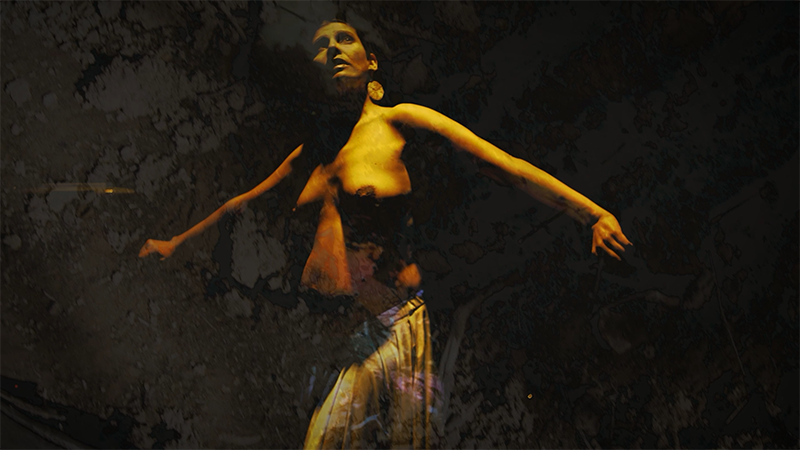
A still from Sandra Paola López Ramírez’ “Latente”
Resuenen‘s closing video is a repeating piece called “Wallers,” created by Joseph Farbrook. Two silhouetted figures on either side of a border wall touch fingers at its juncture. One figure is dark and the other light. The frame flips left to right and the dark figure drains to light. This flipping and color changing happens over and over, forcing us to look at the arbitrary racism implicit in border policing and politics. “Wallers” is graphically stark and effective in its message, a resounding image to finish with. Joseph writes: “‘Wallers’ presents silhouettes in a continuously variable state of race and color, placing them in opposition on either side of an arbitrary wall, yet they reach out to make contact. As our population grows and we compete for resources, we may find reasons to exclude others, until we become the excluded others. Ultimately, we must embrace our entire population as a whole if we are going to have any chance of continuing into a brighter future.”
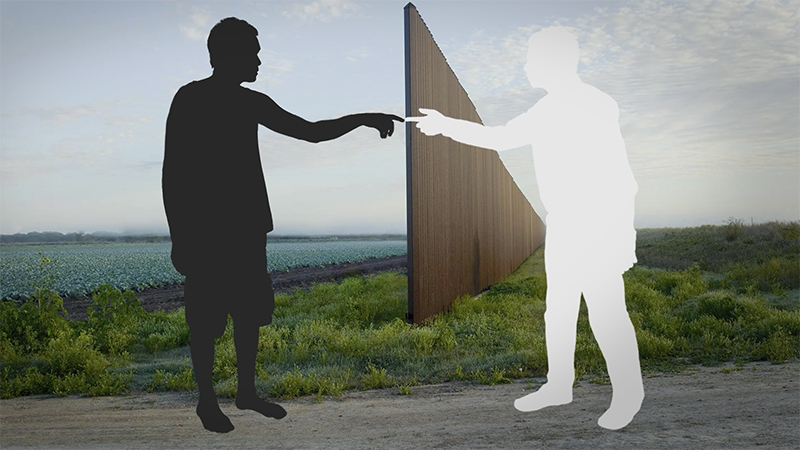
A still from Joseph Farbrook’s “Wallers”
Resuenen does not venture toward literal exposition or overt depiction regarding the border. It’s an abstract artwork evoking sensations of mind and environment intended to stimulate reflection.
With gratitude I acknowledge all collaborating and contributing artists:
Darren Hawk
Damon Smith
Amy Compton
Thomas Carnacki
Tanya Calamoneri
Steed Cowart
Sandra Paola Lopéz Ramiréz
Myles Boisen
Joseph Farbrook
Esteban Allard-Valdivieso
Rick Tyler
Mario De Lara
Arturo Ramon
~~
Resuenen runs just over 34 minutes. It is freely available to anyone interested in screening it. For an MP4 of Resuenen, please write to Micaela Gardner at projectionproject22@gmail.com.
Micaela Gardner is dancer and choreographer originally from the Southwest. Her focus is site dance and dance on film. She has produced works in California, New Mexico, and most recently Baja. She currently lives, teaches, and gardens in San Felipe, Baja.

One Response to “Resuenen: Interpretive Views of the Border”
Thank you for documenting and allowing us into your mythopoetic process. The link to view the film isn’t working. Still, I felt myself on the borderlands of your artistry and am grateful.
Comments are closed.